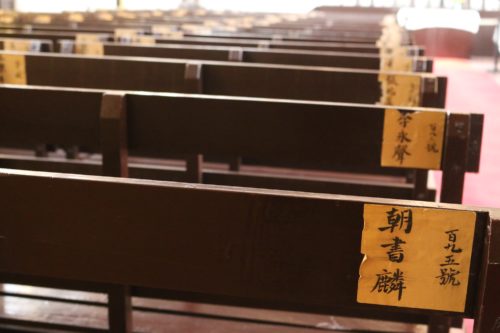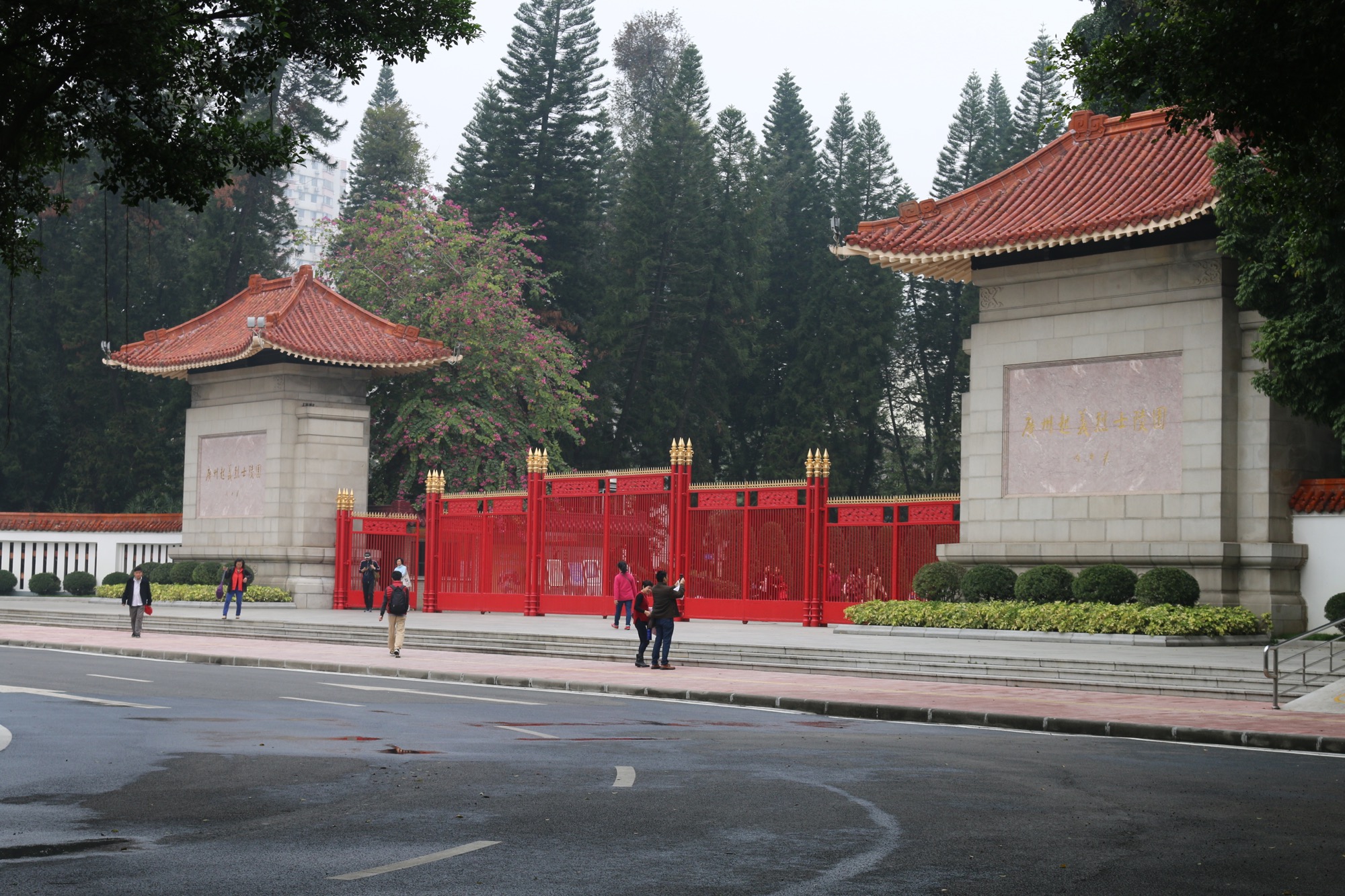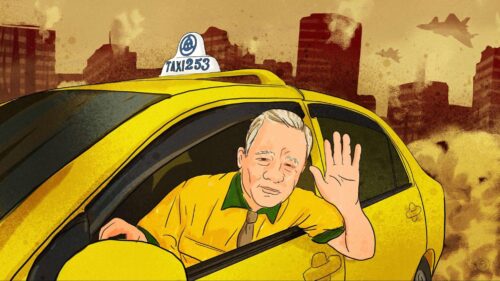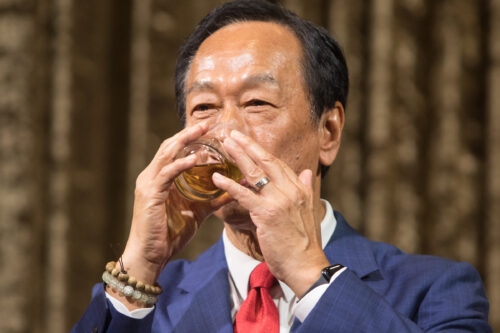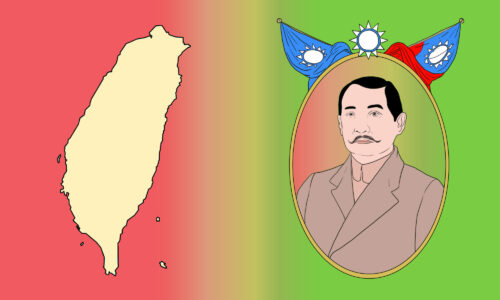A testament to failed compromise: The KMT museums of Guangzhou
The district of Yuexiu in Guangzhou is a diorama of the early history of the CCP and the KMT. It is a blood-stained landscape in miniature, however, and one that looks capable of repeating itself.

Staring over the main hall of the former Zhongshan Library building in Guangzhou, flanked on either side by large Kuomintang and Republic of China flags, is the solemn portrait of a Chinese giant, Sun Yat-Sen 孫中山. He looks down upon the site of the First National Congress of the Kuomintang. The backs of the long, dark-wood pews in the auditorium below still bear the names of the delegates who, from the 20th to 30th of January 1924, crowded here to formally complete the re-establishment of the Chinese KMT, after years of exile.
Amongst the 165 delegates in attendance, however, sat 22 members of the Communist Party, who were representing the CCP in working out an alliance with the KMT so that they might put aside their differences and unite against the greater evils that had torn the country apart. By 1937, half of the Communists would be dead. Six would perish within the next four years. By the time the Communists assumed control of Beijing in 1949, only eight members of their original delegation would still be alive.
The story of the First United Front, the earliest alliance between the KMT and the CCP, began here. While it was born of optimism and had some early successes, after just three years, it would come to a bloody end, foreshadowing some 25 years of protracted war.
For now though, the KMT delegates sit side-by-side with members of the CCP. Indeed, in this early stage of the Chinese Civil War, many of those in attendance are members of both parties concurrently. They are brought together by their shared experience of the “century of humiliation,” in which China was continually bullied and weakened by foreign powers, as its people grew ever poorer. They have all witnessed the repeated attempts to reform the country, to replace the government, and to take back control. All delegates have watched the country tear itself apart and descend into “warlord anarchy” in the aftermath of the 1911 revolution against the imperial regime. Although they hold different visions of what the new China will look like, they agree on what they need to do immediately: rid the country of imperialism and establish a strong government.
To do this, they must first defeat the warlords controlling the north, who they see as stooges and puppets for the colonial powers who prey on China’s divisions to weaken and exploit her (quite rightly, in the case of Zhang Zuolin and Zhang Zongchang, brutal warlords who indulged themselves in luxury and concubines, drinking imported wines and brandies as the rest of the country starved). As Sun proclaims to the congress, “The warlords of our country are cruel and despotic, they see the people as surplus meat, and themselves as the sacrificial cleaver.” Thus, the two parties declare their desire “to create a unified China, in which all peoples are free and united,” in the hope that they “transform this semi-colonial China into an independent one — one that can stand up tall in the world.”
What followed was a brief flourishing of cooperation. The city of Guangzhou, like nowhere else, bears witness to the spirit of optimism in the early days of the United Front. In addition to the KMT flags within Zhongshan Library, down the road, on the same site, sits the Peasant Movement Institute (农讲所 nóng jiǎng suǒ), an ideological academy teaching the tenets of a peasant’s revolution. Originally established by the KMT, it was run jointly with the Communists and played host to early CCP giants Mao Zedong 毛泽东, Peng Pai 澎湃, and Zhou Enlai 周恩来. In nearby Dongshan 东山, a plaque commemorates Mao’s former residence during his stint as “Head of the of the KMT Central Propaganda Committee” in 1925.
The greatest success of this period, however, came in the form of the Northern Expedition of 1926, in which joint KMT/CCP armies defeated their warlord enemies and, for the first time since the Xinhai Revolution of 1911, brought China under one domain.
Beginning officially on the 9th of July, 1926, under the leadership of Generalissimo Chiang Kai-Shek, a combined force of nationalists and communists set out from Guangzhou to defeat the “Beiyang Clique,” which controlled the north of the country. By April 1927, the alliance had captured the major cities of Nanjing and Shanghai, and its armies reached as far north as Bengbu in northern Anhui.
But by December 1928, when the KMT captured Beijing and the last of the Beiyang warlords declared their allegiance to its new government, the alliance had descended into chaos.
History may not hold the answers to cross-strait relations, but it can serve as a parable and a warning to both sides.
Today, in the main hall of the Peasant Movement Institute, a TV screen plays, on a loop, Xi Jinping’s speeches on Marxism. He talks of “Socialism with Chinese Characteristics,” the scientific march of history, and China’s ongoing revolution. More than merely a thinly veiled attempt to put a “Communist” spin on China’s market-driven reforms over the last 30 years, “Socialism with Chinese Characteristics” is an astoundingly complex Marxist analysis of China’s modern history since 1949, as well as an explanation of its future. The last 50 years are broken down into distinct ages with their own goals, merits, and leaders. Xi’s latest contribution to the theory, “Xi Jinping Thought on Socialism with Chinese Characteristics for a New Era,” seeks to explain the necessary conditions for the nation to progress to the next “phase” of the revolution.
In his recent speeches, Xi has re-emphasized the importance of reunifying China with Taiwan as part of the nation’s coming of age, calling it “the great trend of history.” He is thus inheriting the legacy of idealists of the 1920s, who saw unifying the country as a necessary step in ridding China of imperialist humiliations and the first step in building a country that could stand up proudly on the world stage.
The desire of the early KMT and CCP to unite the country is understandable. They were driven by nationalism, which emerged as the most powerful ideal from the dynamic intellectual climate of early 20th-century China. Nationalism triumphed over other causes because of the dire, existential circumstances the country stagnated in. Reforms to the imperial system in the late 19th century had failed repeatedly and China was continually dealt humiliations. The appeal of a nation, a powerful one with modern industries and institutions that could resist the unequal treaties forced upon it, was formidable, and the nationalism that grew out of it has shaped the identities of both the KMT and CCP right up until the modern day.
As Mao himself wrote, “We desire peace. However, if imperialism insists on fighting a war, we will have no alternative but to take the firm resolution to fight to the finish before going ahead with our construction.”
Nowadays, however, China has stood up: the “great powers,” their “unequal treaties,” and their foreign concessions are gone, and Xi’s repeated emphasis on the inevitability of reunification, this time with Taiwan, reeks of repeating unnecessary historical folly.
This stubborn nationalism is not limited to the Chinese side, either. Despite Taiwan’s resolve in the face of increasingly aggressive mainland overtures, it is not clear how the island’s DPP government, which resoundingly rejects Beijing’s calls for reunification, actually hopes to resist them.
Thus, where the mid-1920s saw a shift away from ideological dynamism and optimism toward a more single-minded focus on nationalism and conflict, in recent years, the pragmatism and adaptability that once defined cross-strait relations has too been superseded by conflicting nationalist posturing. The CCP demands that Taiwan be brought under the remit of the PRC and Taiwan flat-out refuses to oblige.
History may not hold the answers to cross-strait relations, but it can serve as a parable and a warning to both sides: the idealism that birthed both the CCP and the KMT was never so stagnant. But when the two parties entrenched in nationalism, it was resolved through decades of bloodshed and war.
The United Front was tested early on when, in the violent leadership struggle triggered by the death of Sun Yat-sen in 1925, Chiang Kai-shek, more right-wing and more militant than his philosophizing predecessor, seized control of the party. In 1926, concerned by efforts of an increasingly powerful left-wing faction to undermine him, Chiang declared martial law in Guangzhou, arrested and expelled major Communist members of the KMT, and sent the party’s Soviet advisors back to Russia, in what came to be known as the “Canton Coupe.” Chiang’s decisive use of military power left him as undisputed leader of the KMT and United Front, ended civilian oversight of the KMT’s National Revolutionary Army, and halted Communist efforts to drag the KMT further to the left.
Moreover, although united by a fierce desire to reunite the country, with the ideological chasm between the parties growing, the prospect of sharing control of a unified China seemed increasingly unlikely. Both parties (not unfairly) suspected the other of planning to force them out of power once the more pressing goal of reunification had been accomplished. Just over three years after the First National Congress, the United Front swiftly unraveled.
Xi’s repeated emphasis on the inevitability of reunification, this time with Taiwan, reeks of repeating unnecessary historical folly.
In April 1927, when a Communist faction led by Zhou Enlai seized control of Shanghai and began organizing a series of fierce strikes, the right-wing elements within the KMT decided it was time to issue a preemptive strike and, on April 2, the party’s Control Commission voted unanimously to purge its Communists members.
In the ensuing violence, now known as the Shanghai Massacre, Chiang employed gangs, thugs, and henchmen to round up and execute thousands of CCP cadres and union workers.
This triggered a repeating pattern of violence whereby sporadic Communist uprisings in cities across China were met with increasingly bloody suppression by the ascendant KMT forces. Likewise, in areas of Communist influence, reactive massacres of KMT forces were common.
In August, as Zhou Enlai fled Shanghai, he arrived in Nanchang, where he staged a similar revolt. Although successful in taking the city, the Communists, fearing KMT retaliation, decided to retreat back to where it all began: Guangzhou, from where they planned to stage a final uprising to install a Communist government in the south. Battles in Chaozhou, along with the ardors of an 800-kilometer “Little Long March” from Jiangxi into Guangdong, however, meant that by the time the Communists arrived in the province, their force had been reduced to as few as 5,000 troops. Then, before the depleted force could make it back to Guangzhou, it was obliterated by KMT-aligned warlords at the Battle of Shantou.
Nonetheless, under pressure from the USSR, the Guangzhou Uprising, as it came to be known, went ahead. Without the help of the armies from Nanchang, however, it was quickly, and brutally, suppressed.
Between them, the Nanchang and Guangzhou Uprisings represent the first engagements of the Chinese Civil War. Beginning with such optimism and passion, modern China’s first attempt at “reunification” would prove ultimately to tear it apart like never before. It is estimated that, in the years 1927 to 1930 alone, 300,000 people were killed as a direct result of the fighting between the CCP and the KMT. The hostilities were fervent, as one Nationalist report boasted about the KMT scourge of its rivals in the south, “There is not a dwelling that has not been burned, not a tree that has not been felled, there is not a fowl or dog that has not been killed, and there is not an able-bodied man remaining.”
Chiang Kai-shek’s loose hegemony over China would last for roughly a decade before it was shattered by the Japanese invasion of 1937. And while the war against Japan would lead to a second KMT-CCP alliance, it would fare no better than its predecessor. The prospect of total control of the motherland would once again prove too alluring, and many historians believe the two parties spent more time fighting each other during the war than they did the Japanese.
Despite recent calls for a peace treaty, the CCP/KMT conflict continues to this day. Indeed, the quest for total control over China not only divided the country, but created two distinct “Chinas” when the KMT was forced to flee to Taiwan in 1949, taking the ROC with them.
And, despite the rise of the DPP and support for the notion of Taiwanese independence in recent years, the Communist perception of this conflict has not changed. Just as Xi’s discourse on reunification draws on the nationalism of the 1920s, the balancing of this nationalism with superficial compromise reminds us of the faulty alliances of the First United Front.
These empty cross-strait compromises, from meetings between Xi and KMT leaders, discussions of future peace talks, and offers to bolster economic cooperation, do little to disguise the widening gulf between each side’s stances on the fundamental issue of re-unification. In calling for the increasingly discredited “One Country, Two Systems” in Taiwan, Xi has revealed his ultimate desire to bring the island under CCP control. Equally, though Beijing may have rejoiced at the success of China-friendly candidates like Han Kuo-yu in Taiwan’s November elections, the majority of Taiwanese oppose re-unification now more than ever. A poll taken just before the elections showed that 83.4 percent of Taiwanese still supported maintaining the “status quo,” whereby Beijing has no political sovereignty over the island. In the wake of Xi’s “One Country, Two Systems” speech, support for outright independence surged by 12 percent, with politicians from across the Taiwanese political spectrum — including KMT legislator and great-grandson of Chiang Kai-Shek Chiang Wan-An — denouncing Xi’s words. While this demonstrates an impressively clear political resolve in Taiwan, the situation is eerily reminiscent of the stubborn and conflicting nationalism held by the early CCP and KMT.
Indeed, this very balancing act, between superficial compromise and powerful nationalist zeal, would have been entirely familiar to Chiang Kai-Shek. Naturally suspicious of leftist elements within his own party, but also wholly dependent on the support of the USSR for the success of his military endeavors, Chiang had to balance the two opposing concerns. He dreamt of ruling over a unified single-party dictatorship, but had to rely on Communist support to bolster his military strength; when he purged the leftists in the Canton Coupe, he compensated by removing hard rightists from their posts also. In the midst of this, however, Chiang never gave up his desire to rule over a whole, “unified” China. But his stubborn resolve, which could not allow for the existence of the Communists, would ultimately prove to be his undoing.
Overshadowed by years of civil war, the sites of the First National Congress and the Peasant Movement Institute, with their KMT flags and praise for the United Front, now stand as somewhat surprising monuments to the superficial cooperation between the two parties. They are testaments to a failed compromise that neither the CCP or the KMT, both set on ruling a unified China on their own, ever expected to work.
Back in Guangzhou, the Martyrs’ Park is the last of the sites commemorating the events of the early Civil War, built in honor of the thousands of cadres killed in the uprising of 1927. It is one of thousands of parks, monuments, and museums across the country that commemorates the slain heroes of the revolution. Indeed, searching Baidu Maps for the term “Martyrs / 烈士” turns the entire map of China deep red, carpeting it in pins, each one representing another site remembering those slaughtered during the Civil War. The prevalence of these sites should serve as a warning, one that should be heeded, lest the conflicts that created them are to be repeated: new ideas, compromise, and pragmatism must be engaged with wholeheartedly, and cannot merely serve as a smokescreen obscuring stagnant idealism that has run its course.
